Comparison of Dislocation Structures in Cu Deformed at Strain Rates from Quasi-Static to Shock Loading Using X-ray Line Profile Analysis
Abstract
:1. Introduction
2. Materials and Methods
2.1. Mechanical Tests
2.2. X-ray Diffraction Measurements
2.3. Evaluation of the X-ray Diffraction Patterns
3. Results
3.1. Dislocation Densities and Character
3.2. Dislocation Arrangement and Subgrain Size
4. Discussion
4.1. Evolution of Dislocation Structure at Different Strain Rates
4.2. Crosscheck of Dislocation Densities in Shocked Samples
4.3. Correlation between the Strength and Dislocation Density
5. Conclusions
Author Contributions
Funding
Data Availability Statement
Acknowledgments
Conflicts of Interest
References
- Meyers, M.A. Dynamic Behavior of Materials; John Wiley & Sons: New York, NY, USA, 1994. [Google Scholar]
- Gurrutxaga-Lerma, B.; Balint, D.S.; Dini, D.; Sutton, A.P. The mechanisms governing the activation of dislocation sources in aluminum at different strain rates. J. Mech. Phys. Solids 2015, 84, 273–292. [Google Scholar] [CrossRef] [Green Version]
- Xu, G.; Argon, A.S. Homogeneous nucleation of dislocation loops under stress in perfect crystals. Philos. Mag. Lett. 2000, 80, 605–611. [Google Scholar] [CrossRef]
- Meyers, M.A.; Gregori, F.; Kad, B.K.; Schneider, M.S.; Kalantar, D.H.; Remington, B.A.; Ravichandran, G.; Boehly, T.; Wark, J.S. Laser-induced shock compression of monocrystalline copper: Characterization and analysis. Acta Mater. 2003, 51, 1211–1228. [Google Scholar] [CrossRef]
- Göttler, E. Versetzungsstruktur und verfestigung von [100]-kupfereinkristallen. Philos. Mag. 1973, 28, 1057–1076. [Google Scholar] [CrossRef]
- Li, Y.S.; Tao, N.R.; Lu, K. Microstructural evolution and nanostructure formation in copper during dynamic plastic deformation at cryogenic temperatures. Acta Mater. 2008, 56, 230–241. [Google Scholar] [CrossRef]
- Cao, B.; Lassila, D.H.; Huang, C.; Xu, Y.; Meyers, M.A. Shock compression of monocrystalline copper: Experiments, characterization and analysis. Mater. Sci. Eng. A 2010, 527, 424–434. [Google Scholar] [CrossRef]
- Lassila, D.H.; Shen, T.; Cao, B.; Meyers, M.A. Effect of low-temperature shock compression on the microstructure and strength of copper. Metall. Mater. Trans. A 2004, 35, 2729–2739. [Google Scholar] [CrossRef]
- Ungár, T.; Ott, S.; Sanders, P.G.; Borbély, A.; Weertman, J.R. Dislocations grain size and planar faults in nanostructured copper determined by high-resolution X-ray diffraction and a new procedure of peak profile analysis. Acta Mater. 1998, 46, 3693–3699. [Google Scholar] [CrossRef]
- Groma, I. X-ray line broadening due to an inhomogeneous dislocation distribution. Phys. Rev. B 1998, 57, 7535–7542. [Google Scholar] [CrossRef]
- Ungár, T.; Gubicza, J.; Ribárik, G.; Borbély, A. Crystallite size distribution and dislocation structure determined by diffraction profile analysis: Principles and practical application to cubic and hexagonal crystals. J. Appl. Crystallogr. 2001, 34, 298–310. [Google Scholar] [CrossRef] [Green Version]
- Ribárik, G.; Gubicza, J.; Ungár, T. Correlation between strength and microstructure of ball-milled Al-Mg alloys determined by X-ray diffraction. Mater. Sci. Eng. A 2004, 387–389, 343–347. [Google Scholar] [CrossRef]
- Ribárik, G.; Jóni, B.; Ungár, T. Global optimum of microstructure parameters in the CMWP line-profile analysis method by combining Marquardt-Levenberg and Monte-Carlo procedures. J. Mater. Sci. Technol. 2019, 35, 1508–1514. [Google Scholar] [CrossRef] [Green Version]
- Ungár, T.; Mughrabi, H.; Rönnpagel, D.; Wilkens, M. X-ray line-broadening study of the cell structure in deformed [001]-oriented copper single crystals. Acta Metall 1984, 32, 333–342. [Google Scholar] [CrossRef]
- Ungár, T.; Frankel, P.; Ribárik, G.; Race, C.P.; Preuss, M. Size-distribution of irradiation-induced dislocation-loops in materials used in the nuclear industry. J. Nucl. Mater. 2021, 550, 152945. [Google Scholar] [CrossRef]
- Meyers, M.A.; Jarmakani, H.; Bringa, E.M.; Remington, B.A. Dislocations in Shock Compression and Release. In Dislocations in Solids; Hirth, J.P., Kubin., L., Eds.; North-Holland: Amsterdam, The Netherlands, 2009; Volume 15, pp. 91–197. [Google Scholar]
- Lu, C.; Remington, B.A.; Maddox, B.R.; Kad, B.; Park, H.S.; Prisbrey, S.T.; Meyers, M.A. Laser compression of monocrystalline tantalum. Acta Mater. 2012, 60, 6601–6620. [Google Scholar] [CrossRef]
- Bringa, E.M.; Rosolankova, K.; Rudd, R.E.; Remington, B.A.; Wark, J.S.; Duchaineau, M.; Kalantar, D.H.; Hawreliak, J.; Belak, J. Shock deformation of face-centred-cubic metals on subnanosecond timescales. Nat. Mater. 2006, 5, 805–809. [Google Scholar] [CrossRef]
- Tramontina, D.; Erhart, P.; Germann, T.; Hawreliak, J.; Hawreliak, J.; Higginbotham, A.; Park, N.; Ravelo, R.; Stukowski, A.; Suggit, M.; et al. Molecular dynamics simulations of shock-induced plasticity in tantalum. High Energy Dens. Phys. 2014, 10, 9–15. [Google Scholar] [CrossRef]
- Jarmakani, H.N.; Bringa, E.M.; Erhart, P.; Remington, B.A.; Wang, Y.M.; Vo, N.Q.; Meyers, M.A. Molecular dynamics simulations of shock compression of nickel: From monocrystals to nanocrystals. Acta Mater. 2008, 56, 5584–5604. [Google Scholar] [CrossRef]
- Gilev, S.D. Nonequilibrium Physical State of Copper under Shock Compression. Combust. Explos. Shock. Waves 2021, 57, 378–384. [Google Scholar] [CrossRef]
- Ungár, T.; Dragomir, I.; Révész, Á.; Borbély, A. The contrast factors of dislocations in cubic crystals: The dislocation model of strain anisotropy in practice. J. Appl. Cryst. 1999, 32, 992–1002. [Google Scholar] [CrossRef] [Green Version]
- Ungár, T.; Ribárik, G.; Balogh, L. Defect-related physical-profile-based X-ray and neutron line profile analysis. Met. Mater. Transact. A 2010, 41, 1202–1209. [Google Scholar] [CrossRef]
- Ribárik, G.; Jóni, B.; Ungár, T. The Convolutional Multiple Whole Profile (CMWP) fitting method, a global optimization procedure for microstructure determination. Crystals 2020, 10, 623. [Google Scholar] [CrossRef]
- Song, Z.; Mo, J.; Zhao, J.; Tan, F.; Yuan, H. Study on launching technique of a 98 kJ electric gun for hypervelocity impact experiments, Int. J. Impact. Eng. 2018, 122, 419–430. [Google Scholar] [CrossRef]
- Hinds, W.C. Aerosol Technology: Properties, Behavior and Measurement of Airborne Particles; Wiley: New York, NY, USA, 1982. [Google Scholar]
- Ungár, T.; Tichy, G.; Gubicza, J.; Hellmig, R.J. Correlation between subgrains and coherently scattering domains. Powder Diffr. 2005, 20, 366–375. [Google Scholar] [CrossRef] [Green Version]
- Krivoglaz, M.A. X-ray and Neutron Diffraction in Non-Ideal Crystals; Springer: Berlin, Germany; New York, NY, USA, 1996. [Google Scholar]
- Wilkens, M. Theoretical aspects of kinematical X-ray diffraction profiles from crystals containing dislocation distributions. In Fundamental Aspects of Dislocation Theory; Simmons, J.A., de Wit, R., Bullough, R., Eds.; National Bureau of Standards: Washington, DC, USA, 1970; pp. 1195–1221. [Google Scholar]
- Ungár, T.; Tichy, G. The effect of dislocation contrast on X-ray line profiles in untextured polycrystals. Phys. Stat. Sol. A 1999, 147, 425–434. [Google Scholar] [CrossRef]
- Wilkens, M. The Determination of Density and Distribution of Dislocations in Deformed Single Crystals from Broadened X-ray Diffraction Profiles. Phys. Stat. Sol. A 1970, 2, 359–370. [Google Scholar] [CrossRef]
- Borbély, A.; Dragomir-Cernatescu, J.; Ribárik, G.; Ungár, T. Computer program ANIZC for the calculation of diffraction contrast factors of dislocations in elastically anisotropic cubic, hexagonal and trigonal crystals. J. Appl. Cryst. 2003, 36, 160–162. [Google Scholar] [CrossRef]
- Dragomir, I.C.; Ungár, T. The dislocations contrast factors of cubic crystals in the Zener constant range between zero and unity. J. Powder Diffr. 2002, 17, 104–111. [Google Scholar] [CrossRef]
- Ungár, T.; Li, L.; Tichy, G.; Pantleon, W.; Choo, H.; Liaw, P.K. Work softening in nanocrystalline materials induced by dislocation annihilation. Scr. Mater. 2011, 64, 876–879. [Google Scholar] [CrossRef]
- Ungár, T.; Tóth, L.S.; Illy, J.; Kovács, I. Dislocation structure and work hardening in polycrystalline OFHC copper rods deformed by torsion and tension. Acta Metall. 1986, 34, 1257–1267. [Google Scholar] [CrossRef]
- Balogh, L.; Brown, D.W.; Mosbrucker, P.; Long, F.; Daymond, M.R. Dislocation structure evolution induced by irradiation and plastic deformation in the Zr-2.5Nb nuclear structural material determined by neutron diffraction line profile analysis. Acta Mater. 2012, 60, 5567–5577. [Google Scholar] [CrossRef]
- Ungár, T.; Stoica, A.D.; Tichy, G.; Wang, X.L. Orientation-dependent evolution of the dislocation density in grain populations with different crystallographic orientations relative to the tensile axis in a polycrystalline aggregate of stainless steel. Acta Mater. 2014, 66, 251–261. [Google Scholar] [CrossRef]
- Mughrabi, H. The α-factor in the Taylor flow-stress law in monotonic, cyclic and quasi-stationary deformations: Dependence on slip mode, dislocation arrangement and density. Curr. Opin. Solid State Mater. Sci. 2016, 20, 411–420. [Google Scholar] [CrossRef]
- Armstrong, R.W.; Arnold, W.; Zerilli, F.J. Dislocation mechanics of copper and iron in high rate deformation tests. J. Appl. Phys. 2009, 105, 023511. [Google Scholar] [CrossRef] [Green Version]
- Meyers, M.A. A mechanism for dislocation generation in shock-wave deformation. Scr. Metall. 1978, 12, 21–26. [Google Scholar] [CrossRef]
- Murr, L.E. Residual microstructure–mechanical property relationships in shock-loaded metals and alloys. In Shock Waves and High-Strain-Rate Phenomena in Metals; Meyers, M.A., Murr, L.E., Eds.; Plenum: New York, NY, USA, 1981; pp. 607–673. [Google Scholar]
- Sliwa, M.; McGonegle, D.; Wehrenberg, C.; Bolme, C.A.; Heighway, P.G.; Higginbotham, A.; Lazicki, A.; Lee, H.J.; Nagler, B.; Park, H.S.; et al. Femtosecond X-ray diffraction studies of the reversal of the microstructural effects of plastic deformation during shock release of tantalum. Phys. Rev. Lett. 2018, 120, 265502. [Google Scholar] [CrossRef] [Green Version]
- Turneaure, S.J.; Renganathan, P.; Winey, J.M.; Gupta, Y.M. Twinning and dislocation evolution during shock compression and release of single crystals: Real-time X-ray diffraction. Phys. Rev. Lett. 2018, 120, 265503. [Google Scholar] [CrossRef] [Green Version]
- Schafler, E. Effects of releasing the hydrostatic pressure on the nanostructure after severe plastic deformation of Cu. Scr. Mater. 2010, 62, 423–426. [Google Scholar] [CrossRef]
- Kerber, M.; Spieckermann, F.; Schuster, R.; Jóni, B.; Schell, N.; Schafler, E. In-situ synchrotron profile analysis after high-pressure torsion deformation. Crystals 2019, 9, 232. [Google Scholar] [CrossRef] [Green Version]
- Taylor, G.I. The mechanism of plastic deformation of crystals. Part I. Theoretical. Proc. R. Soc. A 1934, 145, 362–404. [Google Scholar]
- Gubicza, J.; Chinh, N.Q.; Krállics, G.; Schiller, I.; Ungár, T. Microstructure of ultrafine-grained fcc metals produced by severe plastic deformation. Curr. Appl. Phys. 2006, 6, 194–199. [Google Scholar] [CrossRef]
- Shehadeh, M.A.; Zbib, H.M.; Rubia, T.D.D.L. Multiscale dislocation dynamics simulations of shock compression in copper single crystal. Int. J. Plast. 2005, 21, 2369–2390. [Google Scholar] [CrossRef]
- Chhabildas, L.D.; Asay, J.R. Time-resolved wave profile measurements in copper to megabar pressures. In Proceedings of the Eighth AIRAPT and 19th EHPRG, Uppsala, Sweden, 17 August 1981. [Google Scholar]
- Kraus, R.G.; Davis, J.P.; Seagle, C.T.; Fratanduono, D.E.; Swift, D.C.; Brown, J.L.; Eggert, J.H. Dynamic compression of copper to over 450 GPa: A high–pressure standard. Phys. Rev. B 2016, 93, 134105. [Google Scholar] [CrossRef] [Green Version]


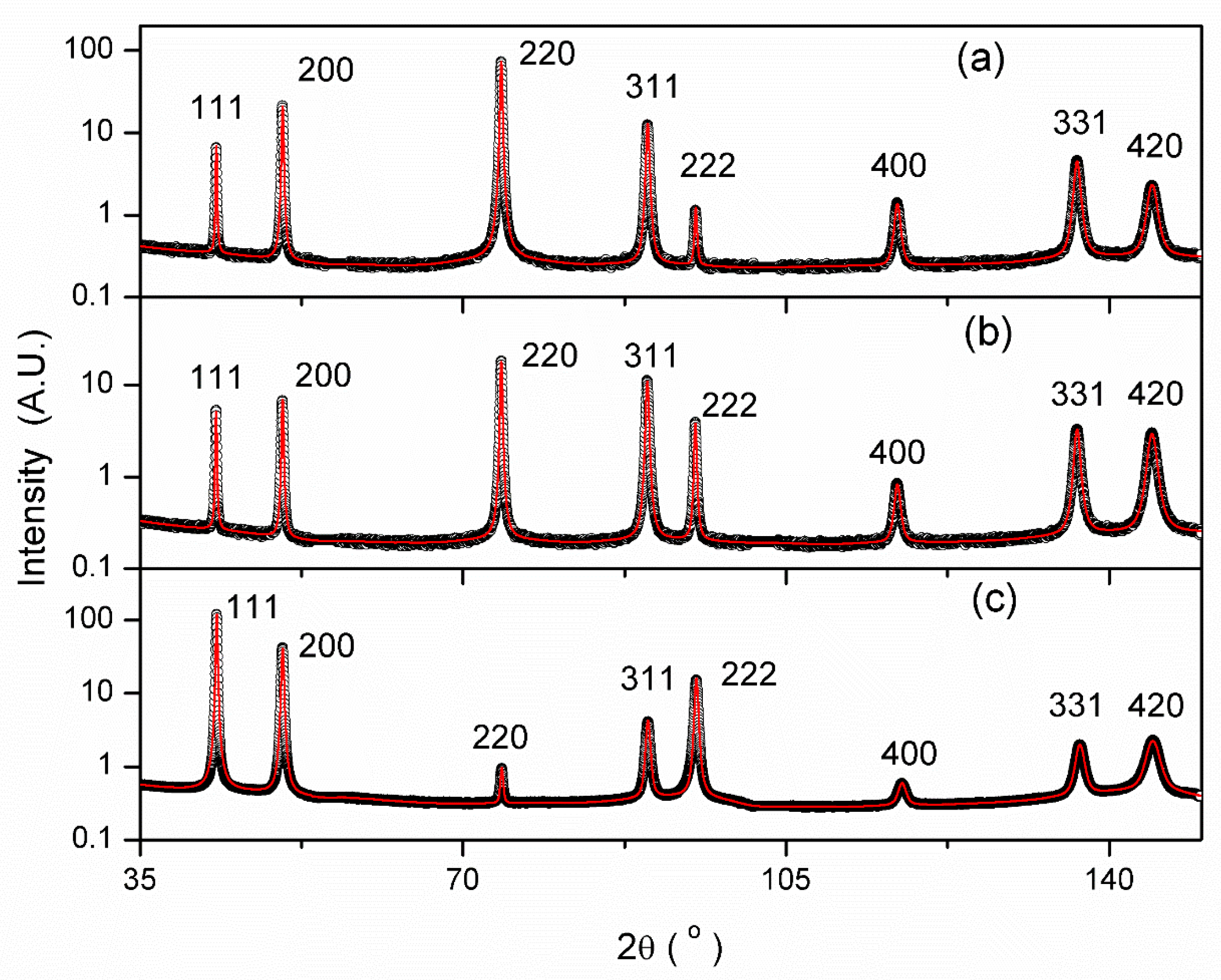
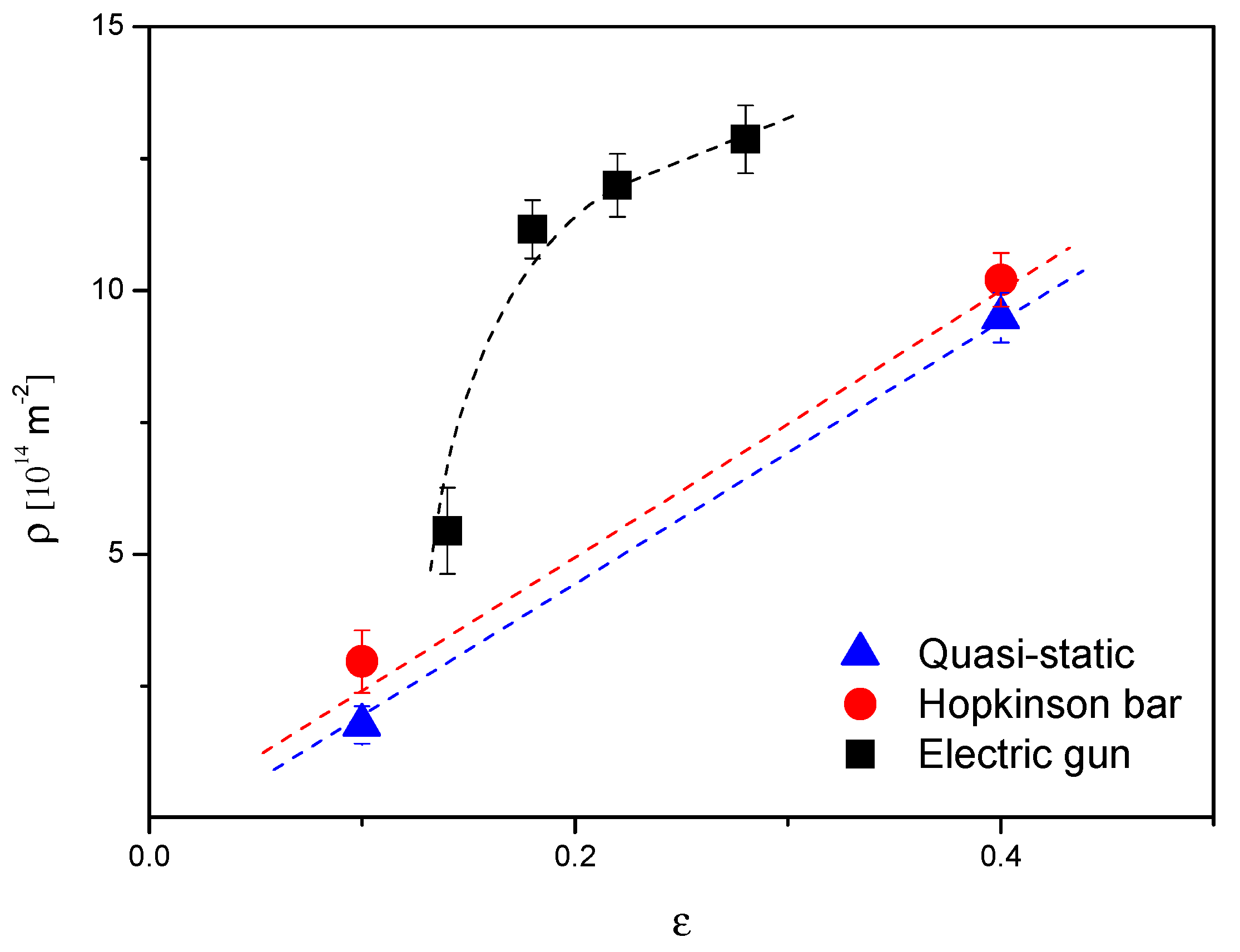
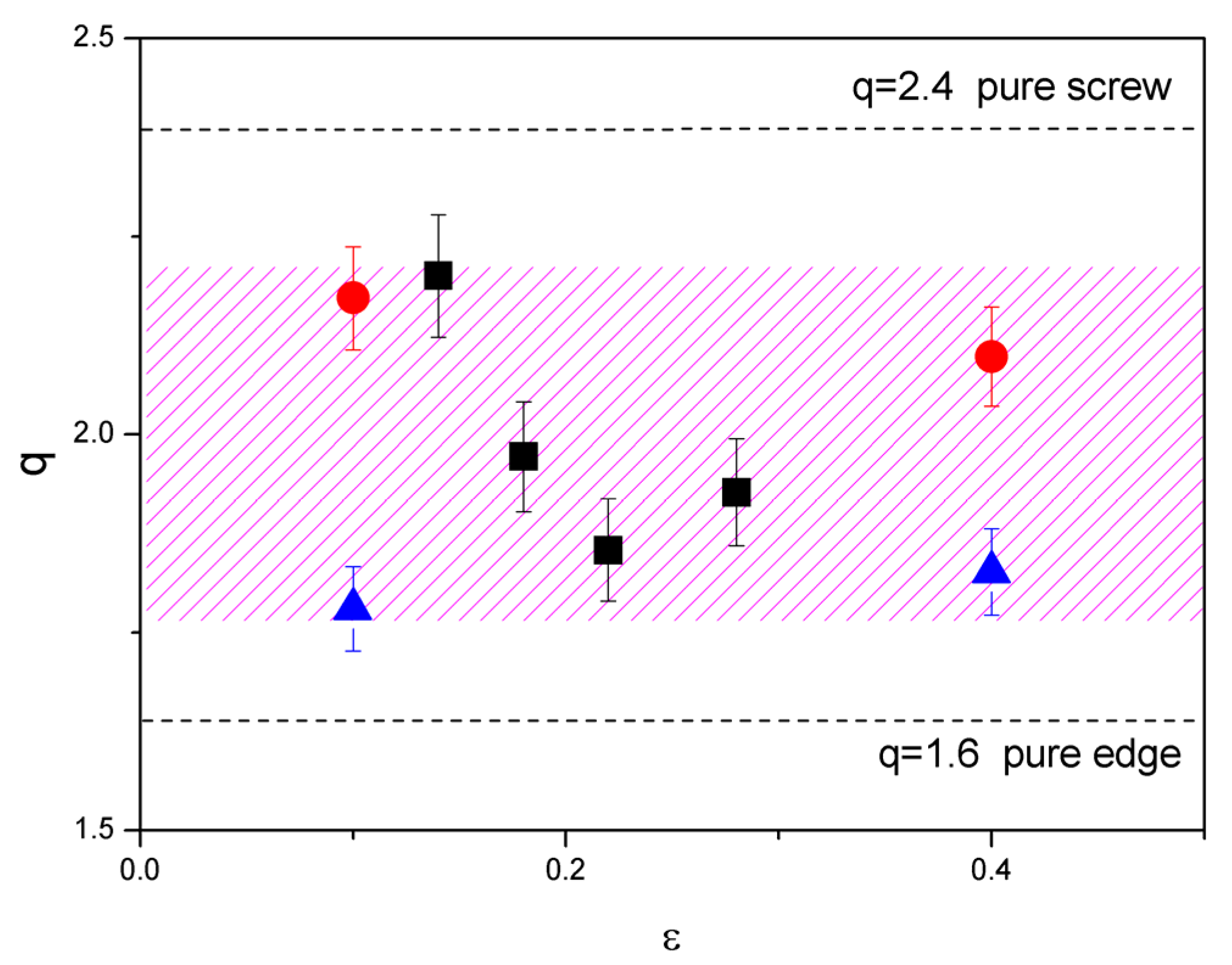
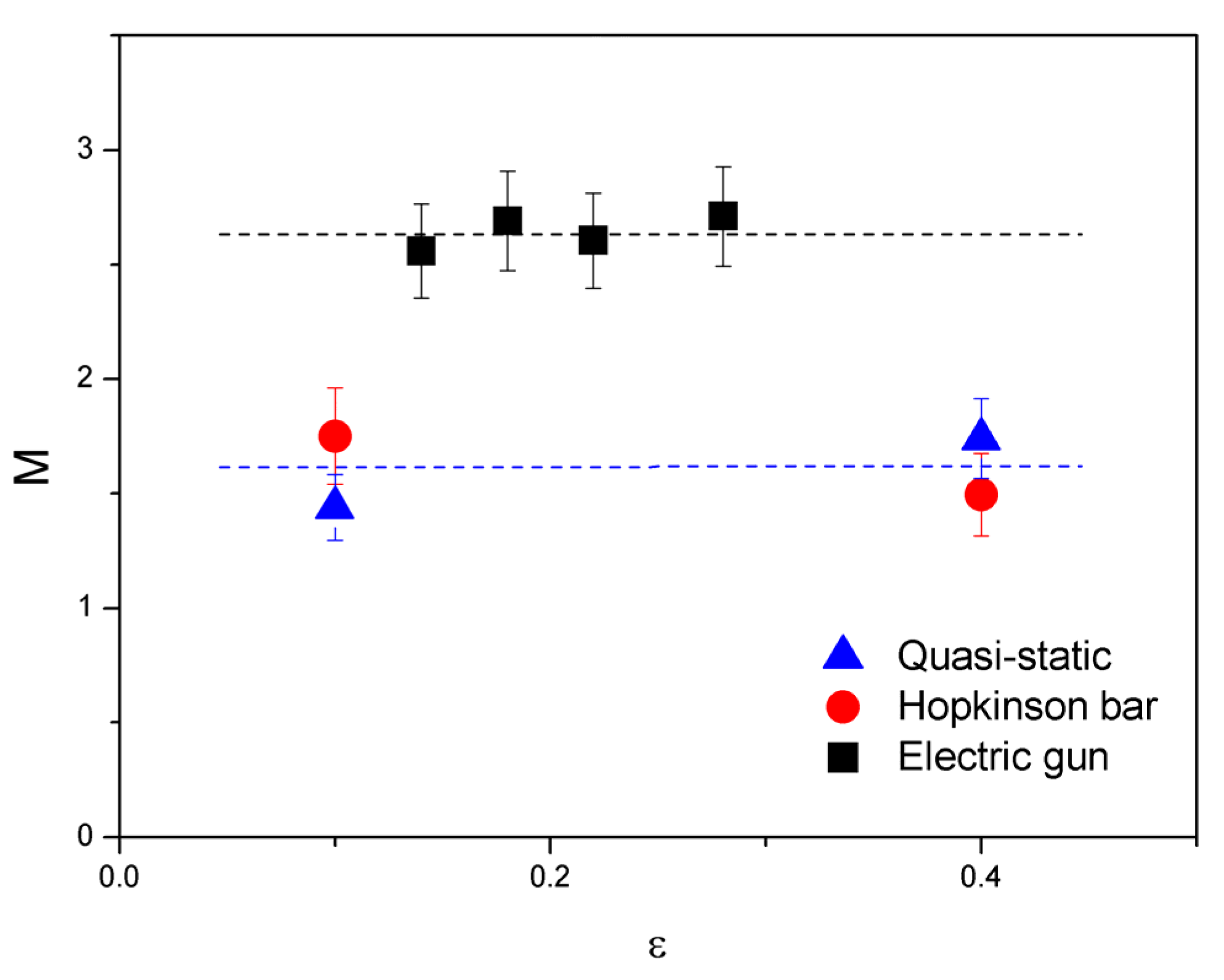
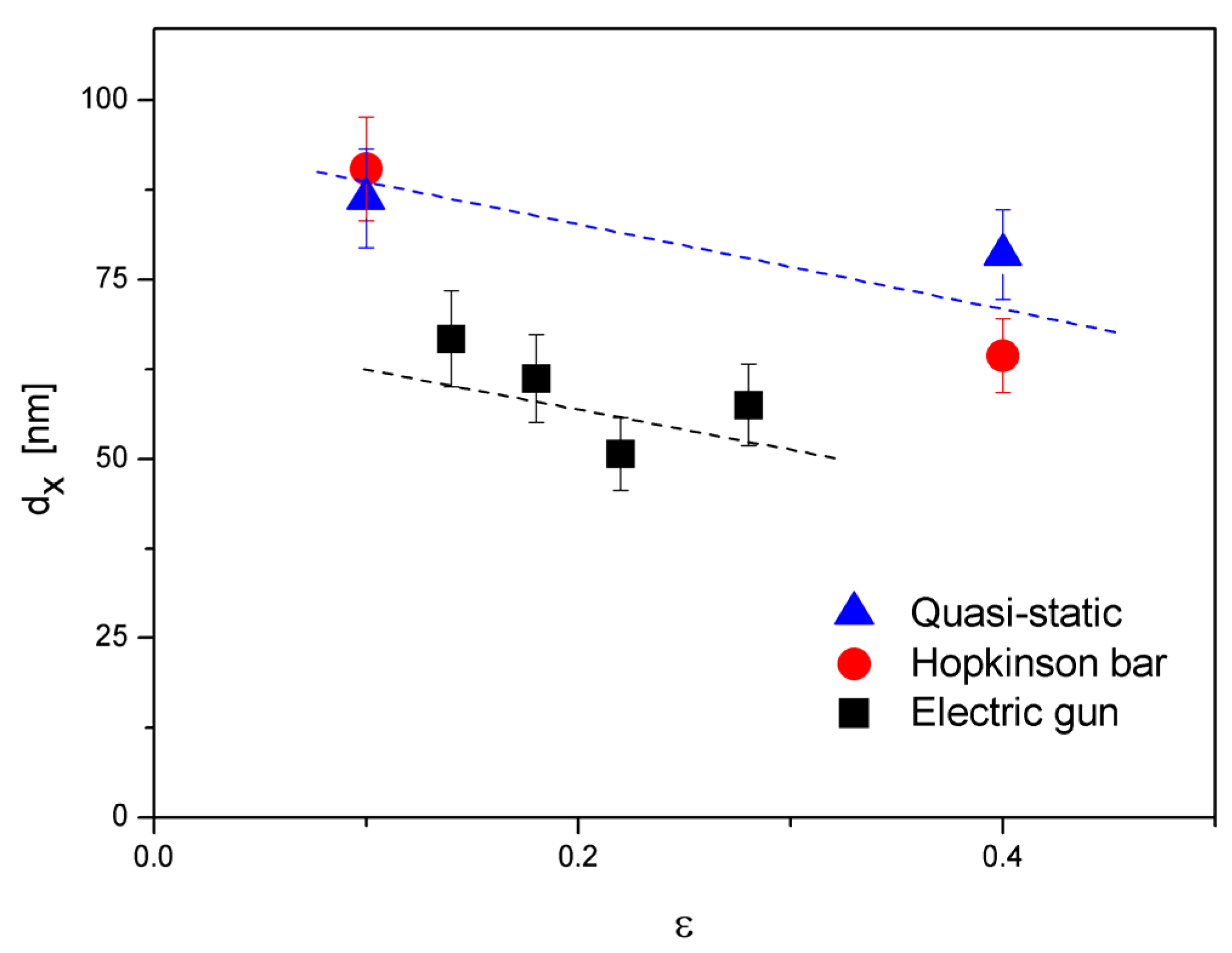
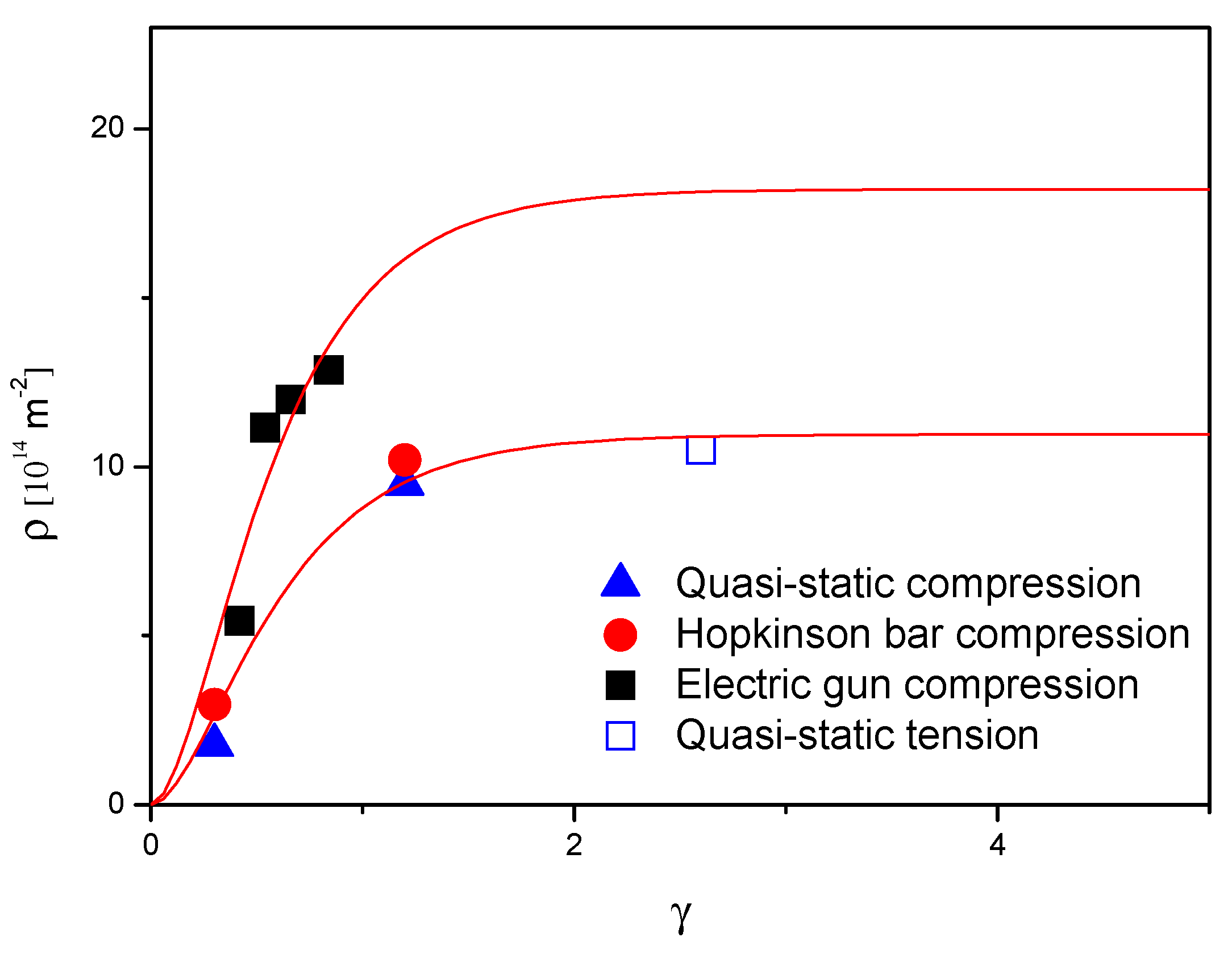
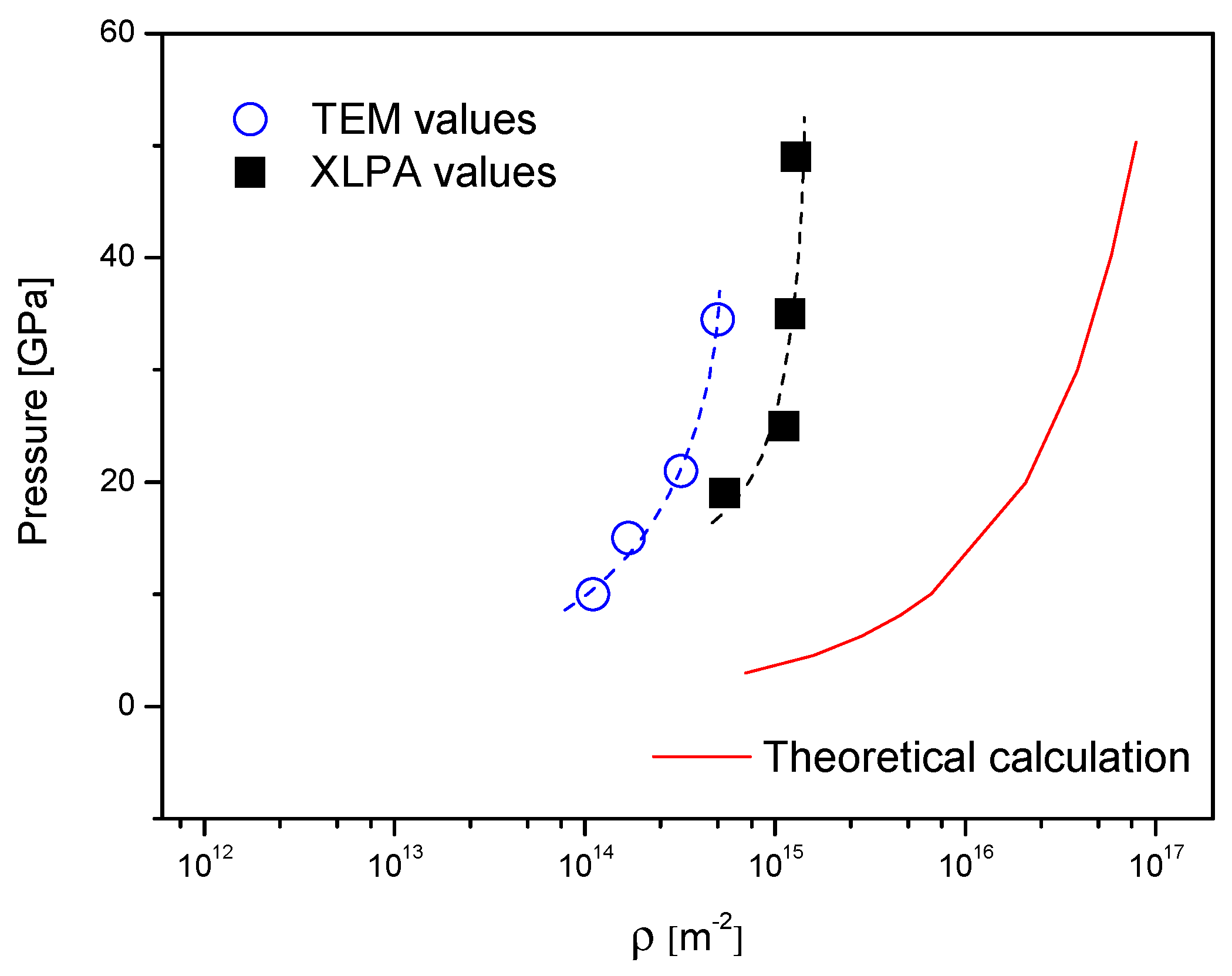
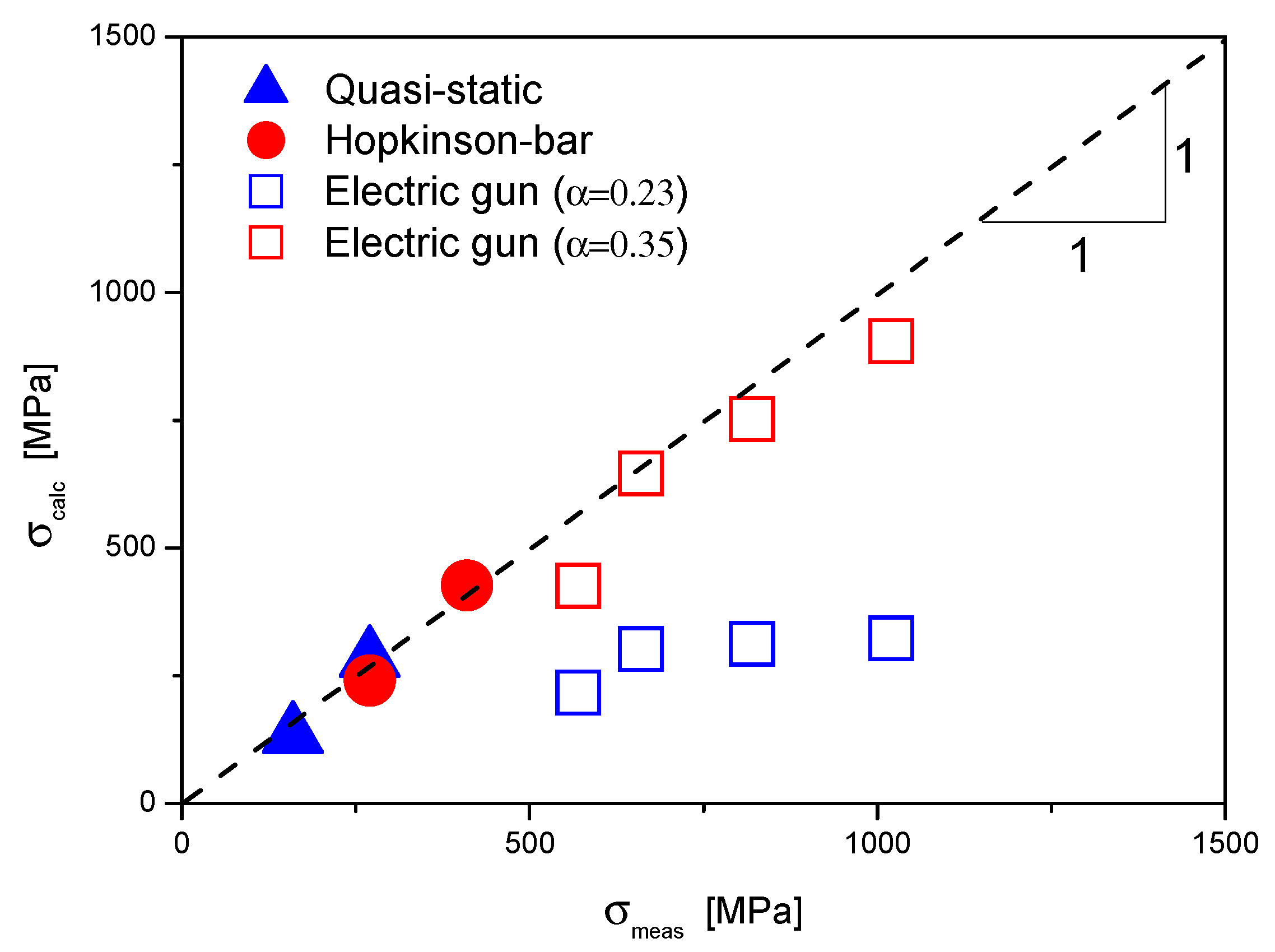
Disclaimer/Publisher’s Note: The statements, opinions and data contained in all publications are solely those of the individual author(s) and contributor(s) and not of MDPI and/or the editor(s). MDPI and/or the editor(s) disclaim responsibility for any injury to people or property resulting from any ideas, methods, instructions or products referred to in the content. |
© 2023 by the authors. Licensee MDPI, Basel, Switzerland. This article is an open access article distributed under the terms and conditions of the Creative Commons Attribution (CC BY) license (https://creativecommons.org/licenses/by/4.0/).
Share and Cite
Fan, Z.; Song, Z.; Jóni, B.; Ribárik, G.; Ungár, T. Comparison of Dislocation Structures in Cu Deformed at Strain Rates from Quasi-Static to Shock Loading Using X-ray Line Profile Analysis. Crystals 2023, 13, 1252. https://doi.org/10.3390/cryst13081252
Fan Z, Song Z, Jóni B, Ribárik G, Ungár T. Comparison of Dislocation Structures in Cu Deformed at Strain Rates from Quasi-Static to Shock Loading Using X-ray Line Profile Analysis. Crystals. 2023; 13(8):1252. https://doi.org/10.3390/cryst13081252
Chicago/Turabian StyleFan, Zhijian, Zhenfei Song, Bertalan Jóni, Gábor Ribárik, and Tamás Ungár. 2023. "Comparison of Dislocation Structures in Cu Deformed at Strain Rates from Quasi-Static to Shock Loading Using X-ray Line Profile Analysis" Crystals 13, no. 8: 1252. https://doi.org/10.3390/cryst13081252
APA StyleFan, Z., Song, Z., Jóni, B., Ribárik, G., & Ungár, T. (2023). Comparison of Dislocation Structures in Cu Deformed at Strain Rates from Quasi-Static to Shock Loading Using X-ray Line Profile Analysis. Crystals, 13(8), 1252. https://doi.org/10.3390/cryst13081252




